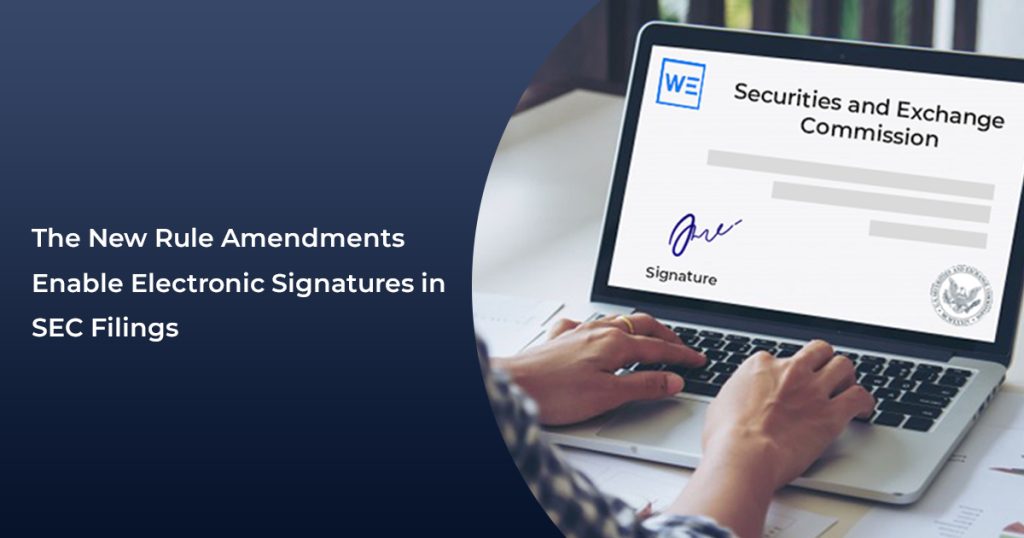The New Rule Amendments Enable Electronic Signatures in SEC Filings

sec electronic signatures: Recently, the Securities and Exchange Commission adopted some new rules for allowing the use of electronic signature software online. The rule was with the signature authentication of documents in connection with some filings with the Commission including the ones submitted through EDGAR.
The rule became official and was put in effect from December 4th and included amendments to Regulations S-T and the EDGAR Filer Manual. In addition, it also included corresponding revisions to rules and forms under the Securities Act of 1933, the Investment Company Act of 1940, and the Securities Exchange Act of 1934.
New Amendments Enable the Use of Electronic Signatures in SEC Filings Easily
The new amendments that are introduced by the Securities and Exchange Commission adopt the rules and the rule amendments that offer additional flexibility.
When users file any document with the Commission, they will be able to use electronic signatures in verifying the documents, facilitating the electronic service, and filing in the administrative proceedings of a Commission.
The agency designed the new amendments and rules to modernize and strengthen its operations.
The amendments implemented understand the wide use of electronic signatures and technological developments needed to ensure the security and authentication of e-signatures.
They will help the users to sign and authenticate the documents very easily while making the entire procedure much easier and more effective.
Earlier Rule
According to this Rule 302(b) of the Regulation S-T previously required all signatories to do a filing submitted through EDGAR manually. This included signing a paper or a document authentication of any online signature that appeared in typed form in such filing.
The Division of Corporation Finance, Division of Trading and Markets, and the Division of Investment Management in the SEC issued a statement in March. This statement included relaxing manual signature requirements because of the COVID-19 pandemic.
This statement provided the staff to not recommend any enforcement action if the signatories used free electronic signature to a word document to compile the authentication documents.
It also provided the signatories to comply with all other requirements of Regulation S-T. The amendment done now reflects a permanent implementation of the relief provided in the March guidance.
SEC acknowledged technological development in the security and authentication of these signatures and the large use of the free electronic signature.
Hence, it permitted the e-sign documents to provide flexibility in complying with the authentication requirements while also maintaining procedural safeguards consistent with evidentiary purpose.
What do the Amendments Say?
The amendments made to the manual offer when a signatory signs an authentication document using an electronic signature, the signing process for electronic signature should
- Present a logical, digital credential or physical that validates the identity of a signatory.
- Provide reasonably for non-repudiation of the signature.
- Include a timestamp for recording the date and time of the electronic signature. The amendments made to the manual clearly define the term credential as an object or data structure that is managed and possessed by an individual to assert identity and provide authentication. It also provides non-repudiation as an assurance that no individual can falsely deny after performing a particular action.
- Affix, attach, and logically associate the signature with the document or signature page being signed.
Additional Signature and Document Signing Requirements
For furthering the authentication requirements, rule 302(b)(2) demands something. When any signatory signs an authentication document using an e-signature online, the signatory should also sign a document manually.
This helps in attesting that the signatory agrees that the use of e-signature includes the legal equivalent of a manual signature for the purpose of authenticating the signature to any filing.
Retain these manually signed documents as long as the signatory uses an electronic signature for authentication. Furthermore, for at least seven years after the date of the recent electronically signed authentication document, a copy should be provided upon request to the Commission.
Rule 302(b)(3) now requires electronically storing all manually signed documents retained under Rule 302(b)(3). The Commission also amends corresponding rules under the Securities Exchange Act of 1934, the Securities Act of 1933, and the Investment Company Act of 1940.
It enabled the use of authentication documents in link with other important filings that included typed as opposed to manual signatures.
The amendment extends a parallel treatment to filers and also allows to electronically sign the authentication documents under similar conditions as applicable to electronic files under Rule 302(b).
Conclusion
Now, while using an electronic signature for the purpose of signing authentication documents, the undersigned will agree with the use of an electronic signature. They must include the legal equivalent of the undersigned’s manual signature for purpose of authenticating the signature to an SEC filing for which it is provided.
The undersigned will also retain this attestation for as long as the undersigned may use an electronic signature to sign an authentication document.
This document must be pursuant to Rule 302 of Regulation S-T and for a period of seven years after the date of the recent electronically signed authentication document.
